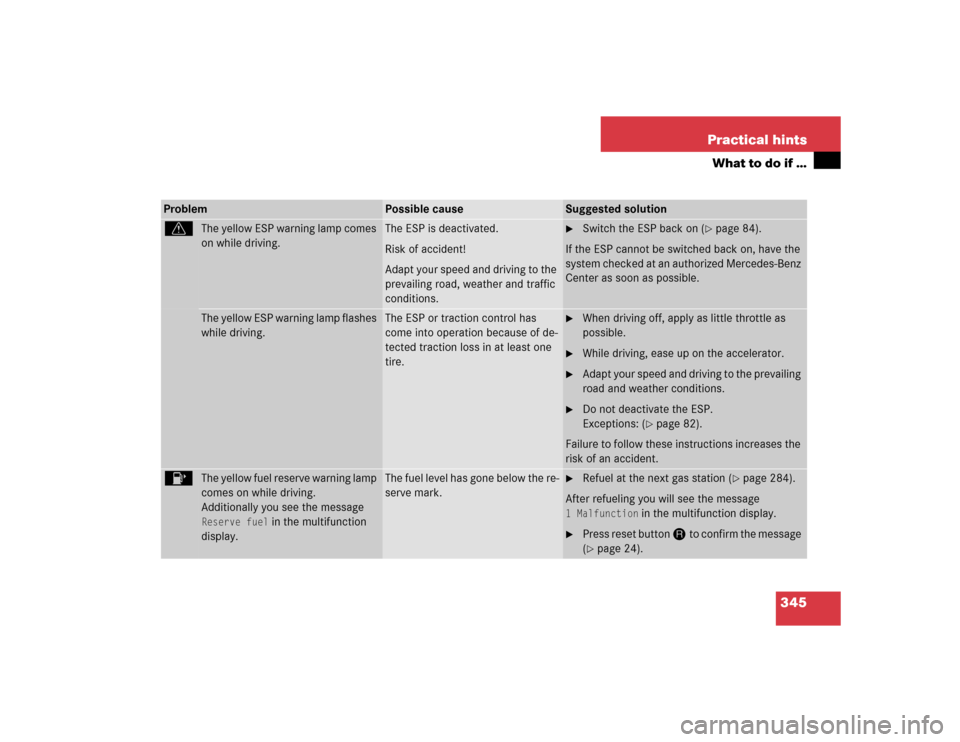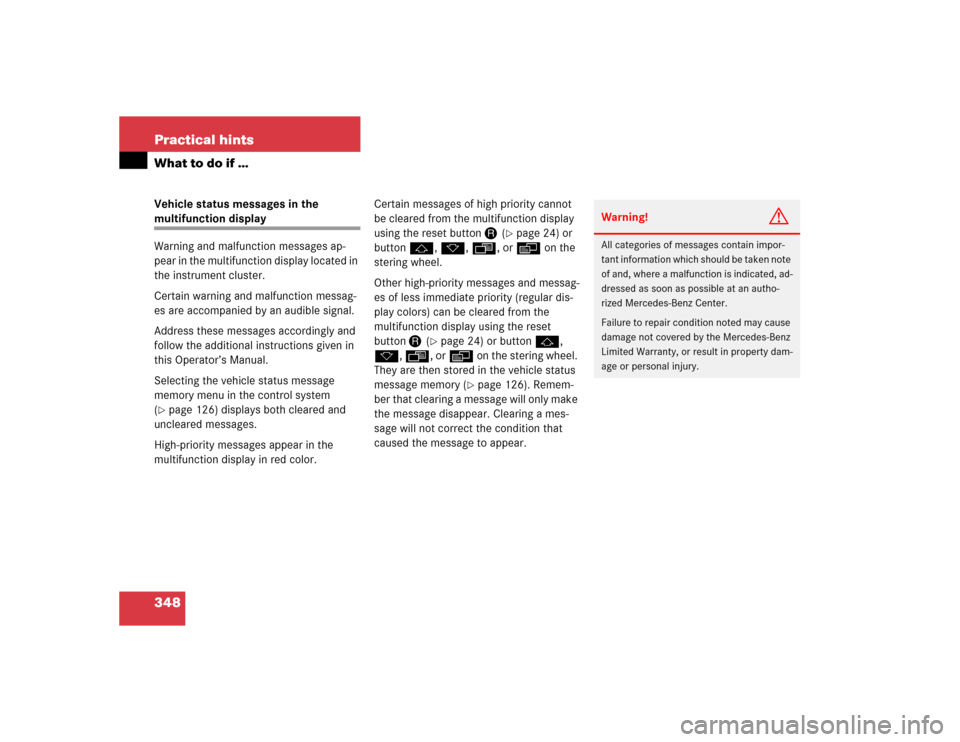Page 345 of 464

345 Practical hints
What to do if …
v
The yellow ESP warning lamp comes
on while driving.
The ESP is deactivated.
Risk of accident!
Adapt your speed and driving to the
prevailing road, weather and traffic
conditions.
�
Switch the ESP back on (
�page 84).
If the ESP cannot be switched back on, have the
system checked at an authorized Mercedes-Benz
Center as soon as possible.
The yellow ESP warning lamp flashes
while driving.
The ESP or traction control has
come into operation because of de-
tected traction loss in at least one
tire.
�
When driving off, apply as little throttle as
possible.
�
While driving, ease up on the accelerator.
�
Adapt your speed and driving to the prevailing
road and weather conditions.
�
Do not deactivate the ESP.
Exceptions: (
�page 82).
Failure to follow these instructions increases the
risk of an accident.
4
The yellow fuel reserve warning lamp
comes on while driving.
Additionally you see the message Reserve fuel
in the multifunction
display.
The fuel level has gone below the re-
serve mark.
�
Refuel at the next gas station (
�page 284).
After refueling you will see the message
1 Malfunction
in the multifunction display.
�
Press reset buttonJ to confirm the message
(�page 24).
Problem
Possible cause
Suggested solution
Page 348 of 464

348 Practical hintsWhat to do if …Vehicle status messages in the multifunction display
Warning and malfunction messages ap-
pear in the multifunction display located in
the instrument cluster.
Certain warning and malfunction messag-
es are accompanied by an audible signal.
Address these messages accordingly and
follow the additional instructions given in
this Operator’s Manual.
Selecting the vehicle status message
memory menu in the control system
(�page 126) displays both cleared and
uncleared messages.
High-priority messages appear in the
multifunction display in red color.Certain messages of high priority cannot
be cleared from the multifunction display
using the reset buttonJ (
�page 24) or
buttonj, k, ·, orè on the
stering wheel.
Other high-priority messages and messag-
es of less immediate priority (regular dis-
play colors) can be cleared from the
multifunction display using the reset
buttonJ (
�page 24) or buttonj,
k, ·, orè on the stering wheel.
They are then stored in the vehicle status
message memory (
�page 126). Remem-
ber that clearing a message will only make
the message disappear. Clearing a mes-
sage will not correct the condition that
caused the message to appear.
Warning!
G
All categories of messages contain impor-
tant information which should be taken note
of and, where a malfunction is indicated, ad-
dressed as soon as possible at an autho-
rized Mercedes-Benz Center.
Failure to repair condition noted may cause
damage not covered by the Mercedes-Benz
Limited Warranty, or result in property dam-
age or personal injury.
Page 349 of 464
349 Practical hints
What to do if …
On the pages that follow, you will find a
compilation of the most important warning
and malfunction messages that may ap-
pear in the multifunction display.
For your convenience the messages are
divided into two sections:�
Text messages (
�page 350)
�
Symbol messages (
�page 355)
Warning!
G
No messages will be displayed if either the
instrument cluster or the multifunction dis-
play is inoperative.
Contact your nearest authorized
Mercedes-Benz Center.
iSwitching on ignition (
�page 35)
causes all instrument cluster lamps
(except high beam headlamp indicator
lamp and turn signal indicator lamps
unless activated) as well as the multi-
function display to come on. Make sure
the lamps and multifunction display are
in working order before starting your
journey.
Page 368 of 464
368 Practical hintsWhat to do if …Display symbol
Display message
Possible cause
Possible solution
<
Seat belt system
Visit workshop
The seat belt system is malfunction-
ing.
�
Visit an authorized Mercedes-Benz Center
as soon as possible.
t
Function
Not available
This display appears if buttons
ort on the multifunction steer-
ing wheel is pressed and the vehicle
is not equipped with a telephone*.
Ê
Close trunk lid
This message will appear whenever
the trunk lid is open.
�
Close the trunk lid.
W
Washer fluid
Top up
The fluid level in the windshield
washer fluid reservoir has dropped
below its minimum mark.
�
Add washer fluid (
�page 295).
Page 380 of 464
380 Practical hintsReplacing bulbsSafe vehicle operation depends on proper
exterior lighting and signaling. It is there-
fore essential that all bulbs and lamp as-
semblies are in good working order at all
times.
Correct headlamp adjustment is extremely
important. Have headlamps checked and
readjusted at regular intervals and when a
bulb has been replaced. See an authorized
Mercedes-Benz Center for headlamp ad-
justment.
Bulbs
iIf the headlamps are fogged up on the
inside as a result of high humidity,
driving the vehicle a short distance with
the lights on should clear up the
fogging.iBackup bulbs will be brought into use
when lamps malfunction. Observe the
messages in the multifunction display
(�page 363).
Page 432 of 464

432 Technical termsCAN system
(C
ontroller A
rea N
etwork)
Data bus network serving to control ve-
hicle functions such as door locking or
windshield wiping.
Cockpit
All instruments, switches, buttons and
indicator/warning lamps in the passen-
ger compartment needed for vehicle
operation and monitoring.
Cold tire inflation pressure
(
�page 323)
Collapsible tire
An especially compact spare tire that
must be inflated with a provided air
pump before using. It should only be
used to bring the vehicle to the nearest
service station.COMAND
(Co
ckpit Man
agement and
D
ata System)
Information and operating center for
vehicle sound and communications
systems, including the radio,
CD changer and navigation system, as
well as other optional equipment (e.g.
telephone).
Control system
The control system is used to call up
vehicle information and to change
component settings. Information and
messages appear in the multifunction
display. The driver uses the buttons on
the multifunction steering wheel to
navigate through the system and to ad-
just settings.
Cruise control
Driving convenience system for auto-
matically maintaining the vehicle speed
set by the driver.Curb weight
(
�page 323)
DOT
(Department o
f Transportation)
(
�page 323)
Engine number
The number set by the manufacturer
and placed on the cylinder block to
uniquely identify each engine pro-
duced.
Engine oil viscosity
Measurement for the inner friction (vis-
cosity) of the oil at different tempera-
tures. The higher the temperature an
oil can tolerate without becoming thin,
or the lower the temperature it can tol-
erate without becoming viscous, the
better the viscosity.
ESP
(Electronic S
tability Pr
ogram)
Improves vehicle handling and direc-
tional stability.
Page 433 of 464

433 Technical terms
ETD
(E
mergency T
ensioning D
evice)
Device which deploys in certain frontal
and rear collisions exceeding the sys-
tem's threshold to tighten the seat
belts. ->SRS
FSS (Canada vehicles)
(F
lexible S
ervice S
ystem)
Maintenance service indicator in the
multifunction display that informs the
driver when the next vehicle mainte-
nance service is due. FSS evaluates en-
gine temperature, oil level, vehicle
speed, engine speed, distance driven
and the time elapsed since your last
maintenance service, and calls for the
next maintenance service accordingly.
GAWR
(G
ross A
xle W
eight R
ating)
(
�page 323)Gear range
Number of gears which are available to
the automatic transmission for shifting.
The automatic gear shifting process
can be adapted to specific operating
conditions using the selector lever.
GPS
(G
lobal P
ositioning S
ystem)
Satellite-based system for relaying
geographic location information to and
from vehicles equipped with special re-
ceivers.
GVW
(G
ross V
ehicle W
eight)
(
�page 323)
GVWR
(Gross V
ehicle W
eight R
ating)
(
�page 324)Head-thorax air bag
Installed in the doors, these air bags
protect occupants during side impact
collisions exceeding a preset thresh-
old. Unlike normal side air bags,
head-thorax air bags are also designed
to provide protection for the head area.
Instrument cluster
The displays and indicator/warning
lamps in the driver’s field of vision, in-
cluding the tachometer, speedometer,
coolant temperature and fuel gauge.
Kickdown
Depressing the accelerator past the
point of resistance shifts the automatic
transmission down to the lowest possi-
ble gear. This very quickly accelerates
the vehicle and should not be used for
normal acceleration needs.
Kilopascal (kPa)
(
�page 324)
Page 434 of 464

434 Technical termsLine of fall
The direct line an object moves down-
hill when influenced by the force of
gravity alone.
Locking knob
Button on the door which indicates
whether the door is locked or un-
locked. Pushing the locking knob down
on an individual door from inside locks
that door.
Maintenance System (U.S. vehicles)
Maintenance service indicator in the
multifunction display that informs the
driver when the next vehicle mainte-
nance service is due. The Maintenance
System in your vehicle tracks distance
driven and the time elapsed since your
last maintenance service, and calls for
the next maintenance service accord-
ingly.Maximum loaded vehicle weight
(
�page 324)
Maximum load rating
(�page 324)
Maximum tire inflation pressure
(�page 324)
Memory function
Used to store three individual seat,
steering wheel and mirror positions for
each SmartKey.
MON
(Motor O
ctane N
umber)
The Motor Octane Number for gasoline
as determined by a standardized
method. It is an indication of a gaso-
line’s ability to resist undesired detona-
tion (knocking). The average of both
the MON (Motor Octane Number) and
->RON (Research Octane Number) is
posted at the pump, also known as
ANTI-KNOCK INDEX.Multifunction display
Two display fields in the instrument
cluster used to present information
provided by the control system.
Multifunction steering wheel
Steering wheel with buttons for operat-
ing the control system.
Normal occupant weight
(
�page 324)
Overspeed range
Engine speeds within the red marking
of the tachometer dial. Avoid this
engine speed range, as it may result in
serious engine damage that is not
covered by the Mercedes-Benz Limited
Warranty.
Poly-V-belt drive
Drives engine components (alternator,
AC compressor, etc.) from the engine.